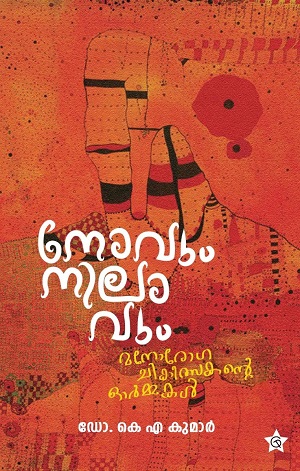BOOK REVIEW
|
|
Access the article online: https://kjponline.com/index.php/kjp/article/view543 doi:10.30834/KJP.38.1.2025.543. Received on:10/06/2025 Accepted on: 19/06/2025 Web Published:23 /06/2025 |
MOONLIGHT OVER THE HISTORY OF PSYCHIATRY IN KERALA
Harish M Tharayil1*
1*Professor and Head, Department of Psychiatry, Government Medical College, Kozhikode, Kerala

This is an attempt to review a fascinating and eminently readable book by one of my teachers in Psychiatry, Dr. K.A. Kumar, who is well-known to the psychiatric fraternity in India. The book is titled “Novum Nilavum, which I am translating as Sufferings and Moonshine. I am not sure whether the moonlight part of it came from the association of moon to mental illness, as in the word “lunacy”.
Dr. Kumar has dedicated this book to his parents: his mother, who taught him the basics of kindness and caring, and his father, who instilled in him a sense of justice and duty. After this, there is a brief preface by him and a very short introduction by the famous Malayalam writer Paul Zacharia. The book has twelve chapters and ends with an afterword by the author himself.
Dr. Kumar is as old as our country, India, as he was fortunate to be born on our day of independence, August 15, 1947. During those days, those regions were under the rule of the Kingdom of Travancore. The first chapter covers his childhood memories in the villages of the erstwhile Travancore kingdom before the formation of the state of Kerala. The geographic details and the nature of the region, which left a deep impression on his mind, as in that of any child, are described in a touching manner with many anecdotes from those days. The warm relationship he shared with his parents and uncle makes a good read.
His first preference was to join for a BA in English language and literature as he had a literary bent of mind. Later, he applied for a medical course and got admission as second on the merit list. His days at the first medical college of Kerala are also described well. His narration of the “ragging days” as a medical student will kindle memories of those days in most of us. Many incidents are about the doyens of medical teaching in Kerala like Dr Thangavelu and others. His interest in matters of the mind was very evident even as an undergrad student; he was reading major books on the subject, including those of Freud, Jung, etc. He was a good reader and an orator from school days, and he never experienced any stage-fright.
In the second chapter, he describes his confusion and hesitation about choosing psychiatry as his specialization. His family was not approving of this choice. Most of the present-day aspirants of Psychiatry would also share this experience, I think. As the experience in Psychiatry during MBBS days was limited and mostly unsatisfactory, he joined JIPMER, Puducherry
(then called Pondicherry) as a Senior House Surgeon. Later, he joined the Government Mental Health Center (GMHC), Oolampara, Thiruvananthapuram, as a tutor in Psychiatry. The sharp contrast between the atmosphere of the academic department at JIPMER and the GMHC is described very well. The sad state of affairs in the mental hospitals of Kerala during those days will be shocking for the present generation. Dr. Kumar has described those days without malice and without naming anyone personally. But the memories of those days haunted him throughout his life.
He got selected for MD Psychiatry at the All India Institute for Mental Health, Bangalore, and joined there in June 1972. During his study period, it was converted into the National Institute of Mental Health and Neurosciences, which was formed by amalgamating the existing All India Institute and the Karnataka State Government Mental Hospital, both of which were located opposite each other on the same road. Hence, Dr. Kumar passed out with an MD in Psychiatry as a member of the first batch of NIMHANS, being the batch topper. Dr. Kumar describes those days with passion, just as he did when describing the days at JIPMER under Dr. P. S. Gopinath.
The next day after completing the course (1975), Dr. Kumar was offered a fellowship at Aarhus University, Denmark, and was promised a faculty position at NIMHANS. But he chose to return to his parent department, the Department of Medical Education of Kerala, and work towards improving the plight of the mentally ill suffering at GMHC, Thiruvananthapuram. His life would have taken a quite different course had he chosen to work at Aarhus, which later became an epicenter of research in Psychiatry. I should not evaluate his decision now with hindsight. However, I still cannot help but wonder whether he would have had the opportunity to make more significant contributions to scientific knowledge if he had chosen that path.
In the later chapters, he recounts his years of service at various medical colleges in Kerala, primarily in Thiruvananthapuram and Kottayam. Key incidents, such as the changes that occurred following Mother Teresa's visit to the GMHC Thiruvananthapuram, which drew media attention to the atrocities taking place there, and the subsequent developments, are narrated.
The situation at GMHC had not changed much even after his return, although the physical amenities were improved. The start of the DPM course in 1975 –’76 was a big relief for the medical teacher in him. His narration about the beginning of lithium treatment would be interesting to present to psychiatrists who use it without much fear of adverse effects. Several tales of the cruelty meted out to patients and the corruption in admissions and discharges may be real news to the present generation.
Though I have not worked at Government Medical College, Kottayam, I have noticed that this is one college where Psychiatry is treated with much more respect by our own colleagues from other specialties. The role of Dr Kumar in this changed attitude is very significant in my opinion, as this is the place where he had spent a considerable period of his early service. The incident involving film director and intellectual John Abraham, who was called to inaugurate the film club of the college, brings out the lifestyle of John very well, as is known to everyone who has been acquainted with him, including me. Dr Kumar had worked briefly at the Government Medical Colleges at Kozhikode and Thrissur too.
The book recounts Dr. Kumar’s experience in organizing the first-ever training for judicial officers in collaboration with the Director of Training of the High Court of Kerala. As a postgraduate trainee in the same Department during the first two editions of this program (1992 / 1993) at Thiruvananthapuram, I can vouch for the quality of the program. The faculty was mainly from NIMHANS and some senior judges of Kerala. It was the period when the Juvenile Justice Act was introduced, and the judges needed to be educated in the basics of child development and psychology. These sessions were conducted by Dr. Shoba Srinath, Head of Child Psychiatry at NIMHANS. Now, the Directorate of Training has blossomed in to a full-fledged Academy for Training Judicial Officers.
There are several incidents described in the book, which may be of interest, not only to the Psychiatry fraternity. Those were the days when there were very few psychiatrists in Kerala, but the relationship among some of the seniors was not at all cordial. He has taken care to present the facts with objectivity, avoiding controversies. Dr. Kumar has taken care to acknowledge and appreciate the supporting role played by many of his colleagues and students during his service, while also being mindful not to reveal the identity of those few whose actions he had to criticize. There are psychiatrists, political leaders, and members of the administrative cadre in the latter group.
The titles of the chapters are very apt. The chapter about GMC Kottayam is titled “In the mainstream of medicine”. In contrast, the chapter about first posting to GMHC borrows a line from a famous old Malayalam movie song equating the earth to “a prison overlooking a black horizon” (from the movie Ashwamedham) hinting that this establishment for treatment of mentally ill persons was mostly a prison working in the old concept of shielding the society from the dangerous lunatics, rather than a place for treatment and convalescence. The chapter on returning to Thiruvananthapuram is titled “Back to the war field”.
The most touching part of the book is when he narrates the close personal bond he had with Shir K. V. Surendranath, the veteran left-wing thinker and political activist, and former member of the Kerala State Legislature. There may be many books about this honest and down-to-earth politician from Kerala, but I am sure his life story would not be complete without this narrative by Dr. Kumar. As a person keen on the plight of mentally ill persons, he goes on to acknowledge another politician, this time from Kozhikode, who always stood up for the welfare of mentally ill - Shri A Sujanapal. He also narrates the time when the Chief Minister of Kerala, Shri EMS Namboothirippad, himself used to come personally, like any ordinary citizen, for the treatment of his wife. The present generation may not believe that such humble politicians ruled our state in the near past.
He ends the book by describing his dream project of establishing an institute for mental health in Kerala, on par with NIMHANS at Thiruvananthapuram. It is gratifying to see that an institute has now been set up in Kerala, at Kozhikode. We can sincerely hope that this will grow up and rise to the level of NIMHANS in the years to come.
The people of Kerala, especially the mental health fraternity, should be grateful to Dr Kumar for creating a book that offers a first-hand take of the mental health care scenario of the most literate state of the country. It is a really gratifying experience for the reader to go through this well-written book. I would wholeheartedly recommend this book to all mental health professionals and the public at large. This book is a welcome addition to the very sparse list of books on the history of Psychiatry and mental health in Kerala. Reading it will be a delight to mental health professionals, and the lay reader would also find the book engaging.
Book: Novum Nilavum (Sufferings and Moonshines); Memoirs of a Psychiatrist
Language: Malayalam
Author: Professor K A Kumar
Publisher: Chintha Publishers, Thiruvananthapuram, February 2025
Distributed by: Deshabhimani Book House, Thiruvananthapuram
The book is available on Amazon.com [Link]
|
Please cite the article as Harish M Tharayil. Moonlight over the history of psychiatry in Kerala. Kerala Journal of Psychiatry 2025; 38(1): 89-91. |






